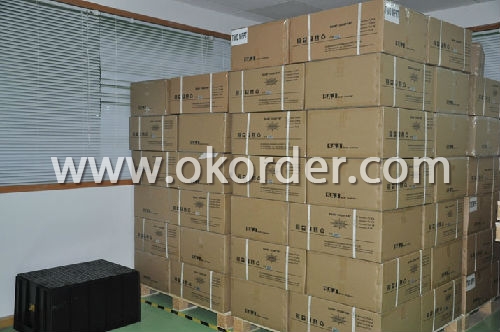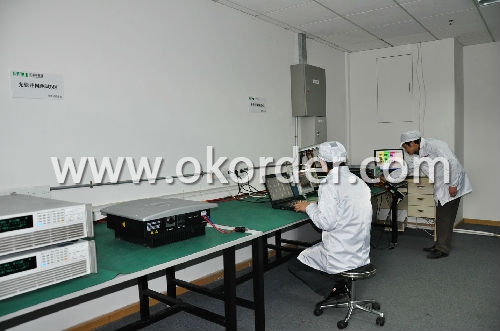Grid Tied Solar Inverter CNBM-2000TL
- Loading Port:
- SHENZHEN
- Payment Terms:
- TT
- Min Order Qty:
- 1 set pc
- Supply Capability:
- 5000 per month pc/month
OKorder Service Pledge
OKorder Financial Service
You Might Also Like
Features of Grid Tied Solar Inverter CNBM-2000TL
CNBM-2000TL is simple national setting of line supply monitoring, Easy country configuration, with Multi-language,display, currently available for most of the countries over the world.With technical creativity and scientific management, the factory established first class R&D and test centers, as well as management and R&D teams comprising of PhDs and masters with overseas qualification.
The full range of CNBM single phase inverters has received VDE, CE, G83/1, G59/2, ENEL2010, VDE4105, C10/C11, AS4777 etc.
Maximum efficiency of 97.8% and wide input voltage range, Internal DCswitch,MTL-String, Sound control,Bluetooth/RF technology /Wi-FiTransformerless,GT topology
Technical data of Grid Tied Solar Inverter CNBM-2000TL
Model | CNBM-2000TL | CNBM-3000TL | |
Input data (DC) |
|
| |
Max. DC power | 2300W | 3200W | |
Max. DC voltage | 500V | 500V | |
Start voltage | 150V | 150V | |
PV voltage range | 100V-500V | 100V-500V | |
Max. input current | 12A | 12A | |
Number of MPP trackers /strings per MPP tracker | 1/2 | 1/2 | |
Output (AC) |
| ||
Rated AC output power | 2000W | 2850W | |
Max. AC power | 2200W | 3000W | |
Max. output current | 11A | 15A | |
Power factor | 1 | 1 | |
THDI | <3% | <3% | |
AC connection | Single phase | Single phase | |
Efficiency |
| ||
Max. efficiency | 97.3% | 97.3% | |
Euro weighted efficiency | 96.50% | 96.50% | |
MPPT efficiency | 99.50% | 99.50% | |
Protection devices |
| ||
Output over voltage protection-varistor | yes | yes | |
Ground fault monitoring | yes | yes | |
Grid monitoring | yes | yes | |
General Data |
| ||
Dimensions (W / H / D) in mm | 360/329/132 | 360/329/132 | |
Weight | 11.7KG | 12.2KG | |
Operating temperature range | –25°C ... +60°C | –25°C ... +60°C | |
Altitude | 2000m(6560ft) without derating | ||
Self-Consumption night | < 0.5 W | < 0.5 W | |
Topology | Transformerless | ||
Cooling concept | Natural | Natural | |
Environmental Protection Rating | IP65 | IP65 | |
Features |
| ||
DC connection | H4/MC4(opt) | H4/MC4(opt) | |
Display | LCD | LCD | |
Interfaces: RS485/RS232/Bluetooth / RF/Zigbee/Wifi | yes/yes/opt/opt/opt | ||
Warranty: 5 years / 10 years | yes /opt | ||
Certificates and approvals | CE、VDE 0126-1-1、DK5940、G83/1-1、G59/2、RD1663、EN50438、 VDE-AR-N4105、CEI-021、IEC-62109、ENEL-Guide | ||
With a R&D team more than 100 engineers,40% of the staff, who has been deeply engaged in the photovoltaic industry for 10 years, CNBM takes the mission to increase the inverter availability and efficiency, putting continuous innovation to make CNBM inverter easier for installation and operation, and more cost-effective for solar plant construction.
Figure 1 the production of Grid Tied Solar Inverter CNBM-2000TL

Figure 2 the test lab of Grid Tied Solar Inverter CNBM-2000TL

- Q:What are the advantages of using a transformerless solar inverter?
- The advantages of using a transformerless solar inverter include increased efficiency, reduced size and weight, lower cost, and improved reliability. Due to the absence of a transformer, these inverters are more energy-efficient, resulting in higher electricity production from the solar panels. They also have a smaller form factor and weigh less, making them easier to install and transport. Transformerless inverters are typically cheaper to manufacture, leading to cost savings for consumers. Additionally, their simplified design without a bulky transformer reduces the likelihood of component failure, enhancing the overall reliability of the system.
- Q:What is the maximum DC input current that a solar inverter can handle?
- The maximum DC input current that a solar inverter can handle depends on the specific model and its design specifications. It can range from a few amps to several hundred amps, depending on the power capacity and intended usage of the inverter. It is important to consult the manufacturer's specifications to determine the exact maximum DC input current for a specific solar inverter.
- Q:How does a solar inverter handle fluctuations in solar panel output?
- A solar inverter handles fluctuations in solar panel output by continuously monitoring the voltage and current from the panels. It adjusts the input parameters to maintain a stable output power, compensating for variations in sunlight intensity, temperature changes, and other environmental factors. This ensures a consistent and reliable supply of electricity from the solar panels to the connected electrical load or the grid.
- Q:What are the different power output modes of a solar inverter?
- The different power output modes of a solar inverter include grid-tie mode, off-grid mode, and hybrid mode. In grid-tie mode, the inverter synchronizes with the utility grid and feeds excess solar power back to the grid. Off-grid mode allows the inverter to operate independently from the grid, providing power to a standalone system or battery storage. Hybrid mode combines both grid-tie and off-grid capabilities, enabling the inverter to utilize solar power while still being connected to the grid for backup or additional power supply.
- Q:How does the size of a solar inverter affect its performance?
- The size of a solar inverter directly impacts its performance. A larger inverter with a higher wattage capacity can handle a greater amount of solar power generated by the panels. On the other hand, a smaller inverter may not be able to efficiently convert and utilize all the energy produced, resulting in a decrease in overall system performance. Therefore, choosing the appropriate size solar inverter is crucial to ensure optimal performance and maximize energy production.
- Q:Can a solar inverter be used with solar-powered streetlights?
- Yes, a solar inverter can be used with solar-powered streetlights. The solar inverter is responsible for converting the direct current (DC) produced by the solar panels into alternating current (AC) that can be used to power streetlights. This conversion allows the solar-powered streetlights to operate efficiently and effectively, utilizing the energy generated by the solar panels.
- Q:How does a solar inverter affect the overall energy consumption of a property?
- A solar inverter affects the overall energy consumption of a property by converting the direct current (DC) electricity produced by solar panels into alternating current (AC) electricity that can be used to power electrical appliances and equipment in the property. It ensures that the electricity generated by the solar panels is compatible with the property's electrical system, reducing the dependence on grid-supplied electricity. By efficiently converting solar energy into usable electricity, a solar inverter helps to lower the property's energy consumption from traditional sources and can potentially result in energy cost savings.
- Q:Can a solar inverter be used with thin-film solar panels?
- Yes, a solar inverter can be used with thin-film solar panels. Thin-film solar panels have a different structure and composition compared to traditional crystalline silicon panels, but they still generate DC electricity that needs to be converted into AC for use in homes or businesses. A solar inverter is responsible for this conversion process, regardless of the type of solar panels used.
- Q:How does a solar inverter handle voltage fluctuations from the solar panels?
- A solar inverter handles voltage fluctuations from the solar panels by employing a technique called Maximum Power Point Tracking (MPPT). The MPPT algorithm continuously monitors the voltage and current output of the solar panels and adjusts the operating point to ensure maximum power transfer. This allows the inverter to adapt to varying sunlight intensity and temperature conditions, efficiently converting the DC power generated by the panels into standard AC power. The inverter also incorporates voltage regulation and protection mechanisms to ensure stable and safe operation despite any voltage fluctuations.
- Q:How does a solar inverter handle ground fault protection?
- A solar inverter handles ground fault protection by continuously monitoring the flow of current between the solar panel array and the ground. If it detects any abnormal current leakage or ground faults, it quickly shuts down the system to prevent any potential electrical hazards or damage.
1. Manufacturer Overview |
|
|---|---|
| Location | Shenzhen,China |
| Year Established | 2010 |
| Annual Output Value | 50 million USD |
| Main Markets | Australia, Euro, America, China. |
| Company Certifications | CE, VDE-AR-N4105, FCC,ETL,CEC,CEI 0-21,G83,G59,SAA,CGC |
2. Manufacturer Certificates |
|
|---|---|
| a) Certification Name | |
| Range | |
| Reference | |
| Validity Period | |
3. Manufacturer Capability |
|
|---|---|
| a)Trade Capacity | |
| Nearest Port | Shenzhen, Guangzhou, Hongkong |
| Export Percentage | 60% |
| No.of Employees in Trade Department | 260 |
| Language Spoken: | English, Chinese |
| b)Factory Information | |
| Factory Size: | 500-1000 |
| No. of Production Lines | 8 |
| Contract Manufacturing | None |
| Product Price Range | 300-40000 USD |
Send your message to us
Grid Tied Solar Inverter CNBM-2000TL
- Loading Port:
- SHENZHEN
- Payment Terms:
- TT
- Min Order Qty:
- 1 set pc
- Supply Capability:
- 5000 per month pc/month
OKorder Service Pledge
OKorder Financial Service
Similar products
New products
Hot products
Hot Searches
Related keywords






























